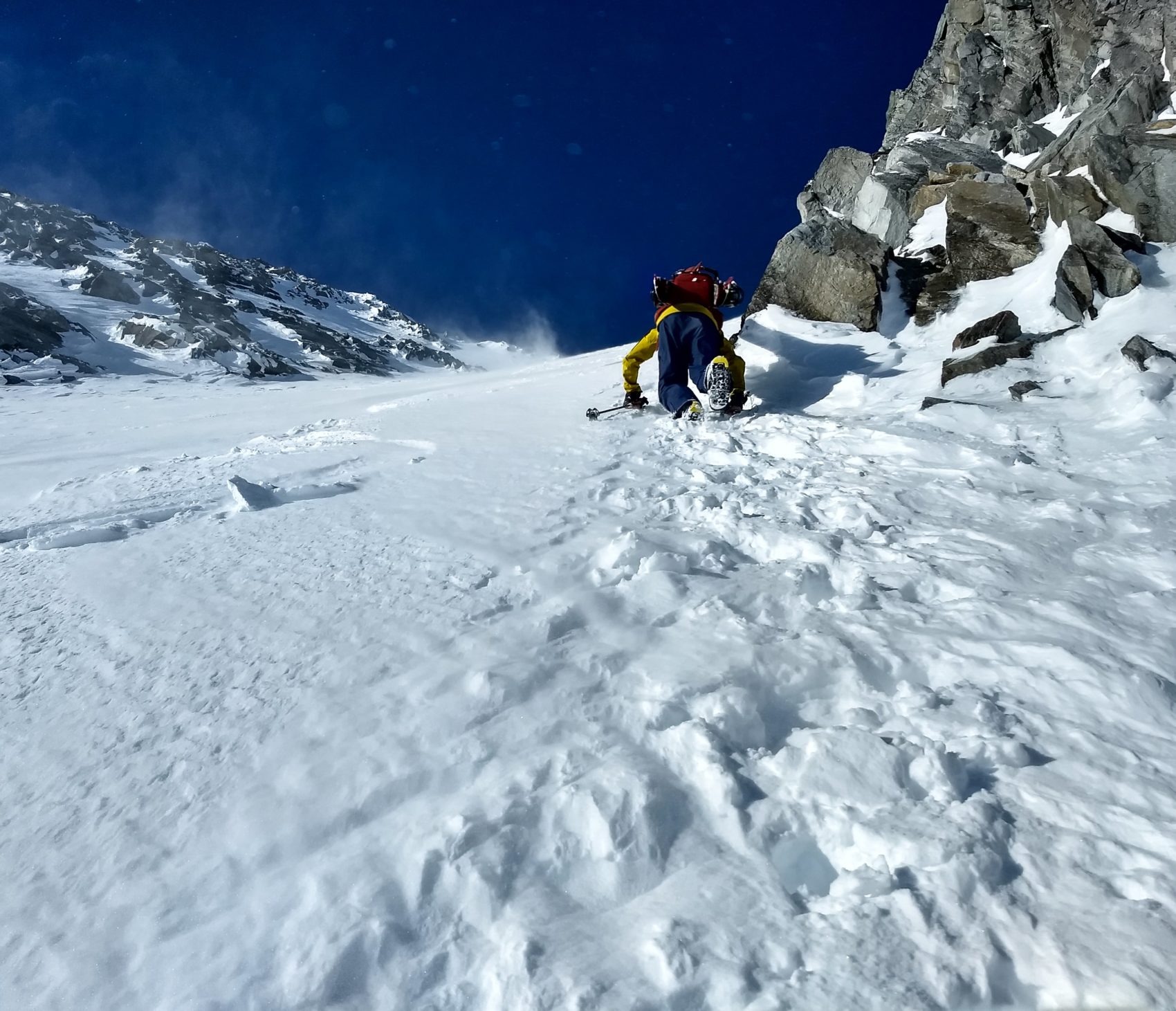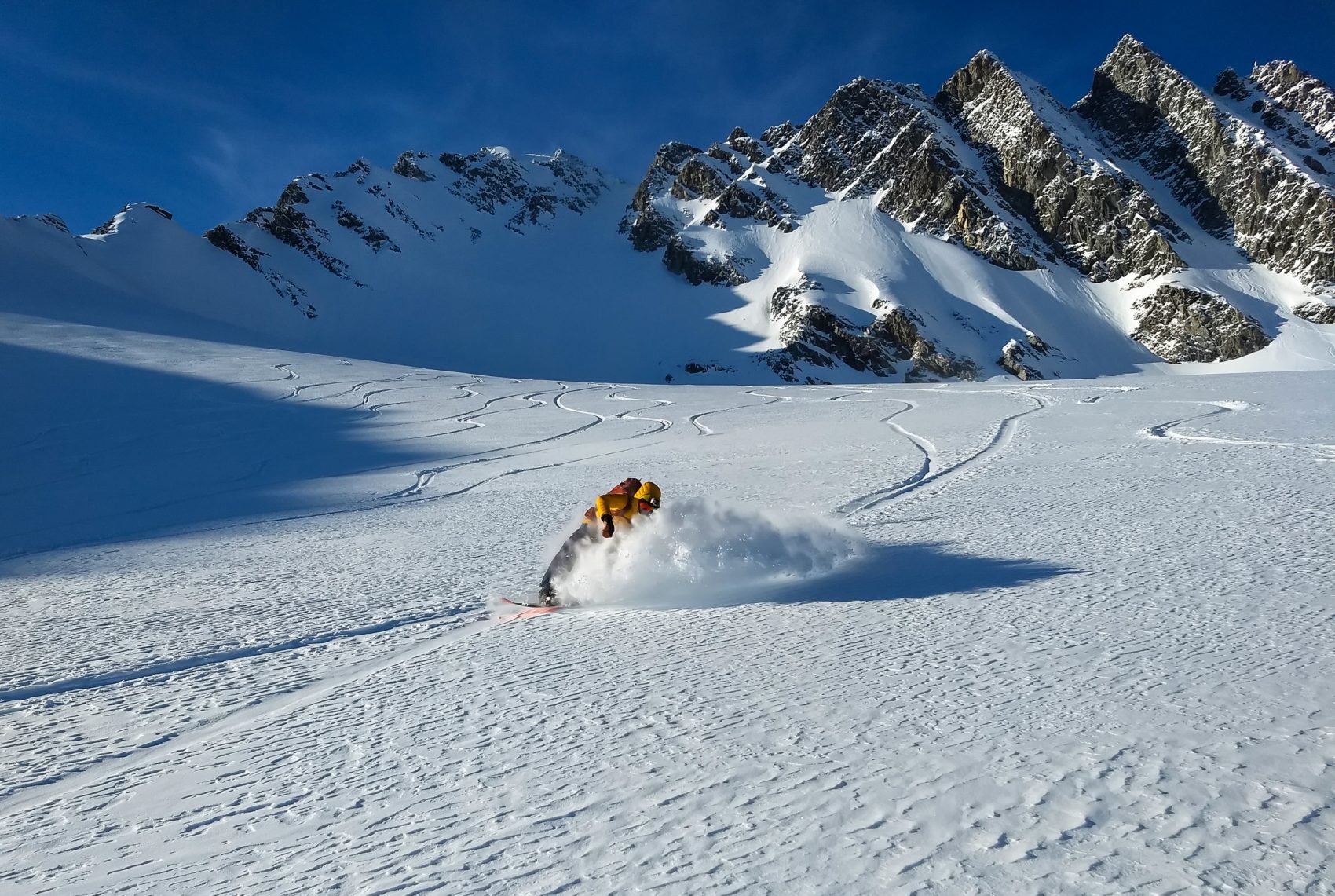
Report from January 29, 2019
Laurent and I were driving up Rogers Pass once again, this time to conquer a titan, Rogers Peak in Glacier National Park. From the top of its 3185 meters, this imposing mountain, the neighboring saw-tooth shaped Swiss Peak and bizarre Mt Tupper dominated the horizon. This area of Glacier National Park reminded me of a miniaturized version of the French Alps.
The excitement in the air was palpable. We peered at the towering mountain range through my Honda’s windshield, scrutinizing our planned itinerary.

The weather was inclement, the skies were void of any cloud. the temperature was set at a balmy -5C and the winds were minimal. The avalanche hazard was ever-present but manageable. What a perfect day for ski-mountaineering!
Exhausted from yesterday’s Mt Afton (2553m) climb, we organized our heavy packs at a leisurely pace. After much debate, Laurent convinced me to bring the glacier travel gear, consisting of the following key items:
- A 50-meter long half rope
- A harness with an assortment of carabiners, a belay device, a few ice screws and two prusik cords
- An ice axe
Eager to start the day, we slapped our skins on and clipped in our bindings at 8:30 AM, a rather late start for the 1950-meter climb awaiting us. We began ascending the short, but steep Hermit Trail, a summer hiking route.

As we gained the sparse tree cover of the sub-alpine at 1800 meters, we noticed the previous climbers’ uptrack diverted south from that of our guide book. Uptracks, Bootpacks & Bushwhacks by Revelstoke resident Douglas Sproul. The climbers opted to travel over a wide ridge, avoiding the convoluted valley to the east. While the established tracks were a minor detour, it presented a much safer alternative, minimizing our exposure to avalanches. It is worth mentioning a good 30cm of consolidated snow laid on top of a thick solar crust creating the perfect sliding interface.

After a magical ascent through the old-growth forest, we emerged from the trees into a heavenly white snowscape. The soft curves of moraines and odd depressions showed evidence of the ongoing glacial retreat, a process which began eons ago. The intense sunlight was reflecting off the perfectly smooth surfaces of the Rogers and Swiss glaciers, temporarily blinding our vision.
I was in my element. I felt right at home.

We took a 5-minute water break, gasping wide-eyed at Mt Sifton’s south face in the distance. In our typical ambitious fashion, we were already looking at the next objective, making plans for the future. We continued the approach up the Swiss Glacier, heads on a swivel, glancing left and right into the limitless expanse of peaks waiting to be climbed.

Past the 2500 meters, I noticed Laurent’s pace was slowing down: altitude fatigue rolling in most likely. With every breath, his lungs were drawing thinner air. Over thousands of steps, the minute lack of oxygen naturally started affecting his energy levels. His body was working harder than ever. It didn’t change his usual light-hearted, positive demeanor, showing a significant strength of mind.

On my end, the heavy burden of the additional glacier gear was taking its toll on me. My shoulders were aching, my knees, shaking. Our objective seemed within an arm’s reach, yet took forever to climb. Doubt filled my mind. Would we make it before sundown? I ignored the thought as well as the pain. We pressed forward, one step after another.
Nothing could stop us on such a spectacular bluebird day.

It took two laborious hours to arrive at the base of Rogers Peak’s south face. Rogers Col crowned the top of the skiable section, gale-force winds sending thin blankets of snow coursing downslope. After careful evaluation, the 45-degree aspect presented a few hazards. On one hand, we spotted a cross-loaded wind slab climber’s left of the face due to the typical southwest winds blowing across the col. On the other, the sheer rock face climber’s right posed a rockfall hazard, the lesser evil in our opinion.
We strapped our skis to our packs, grabbed our ice axes and proceeded up the steep face beneath the rock face, pausing every now and then to catch our breath.

100 meters from Rogers Col, a ferocious northern gust nearly blew us off the face. Laurent buried his ice axe deep in the chalky snow and hugged the slope, holding on to dear life. The sudden burst of adrenaline cleared any altitude-induced lightheadedness, granting us renewed motivation.
Things were getting a little more extreme.

After 90 minutes of strenuous boot-packing, we gained the summit with frozen hands, frosty beards and an overwhelming sense of achievement.

As the sun was nearing the horizon, we leaped off the summit. After successive warm sunny days, the col’s entrance was wind-compacted and crusty. My dull edges struggled to grip the icy snow. A perfect technique was the priority. While a fall wouldn’t be catastrophic, I would potentially slide down a 45-degree, 300-meter long incline at a neck-breaking speed into an icy plateau. I pushed the thought aside and focused on the skiing.

We bolted over the Swiss Glacier, picking up the half rope that I had discarded at the base of the face. We carved effortless turns through 20cm of light, powdery snow. Even after the sun has baked the surface for hours, the underlying glacial ice preserved the ideal snow conditions.

With new-found energy, Laurent converted the alpine slopes into a terrain park, skillfully sending tricks off rollers and boulders.

After skiing through the freeze-thaw crust of the Hermit Valley, we reached the parking lot by 4:30 PM. The setting sun was casting a fiery glow on Mt Rogers. We gladly threw our sweat-soaked gear in the trunk of my Honda. We drove back to Revelstoke on an express mission to Nico’s Pizzeria for (you guessed it) his delicious poutine (with real cheese curds). I believe we have made it a habit by now.

STATISTICS
Peak Elevation: 3185m
Vertical Gain/Loss: ±1950m
Distance: 12.8km
Duration: 8h
AVALANCHE BULLETIN

PHOTOS







